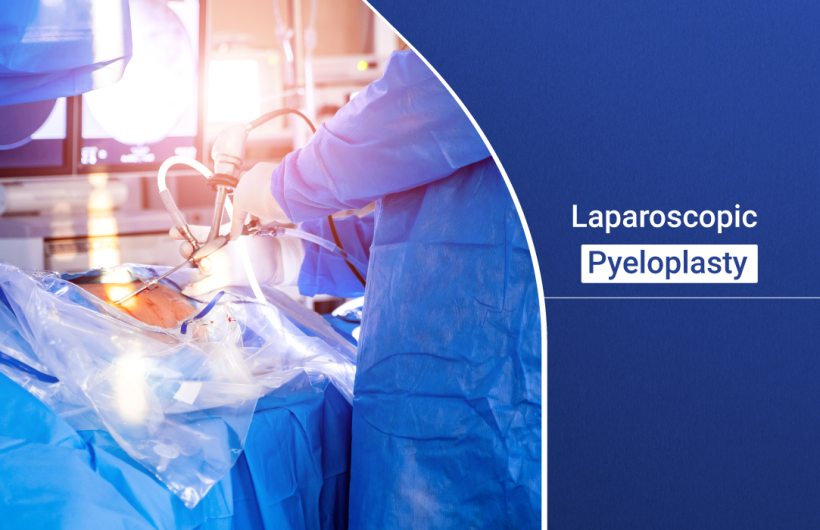What is laparoscopic pyeloplasty?
The region where the ureter meets the kidney is a significant passage through which urine has to go from its factory to its initial road towards execration. In many patients, the tissue which makes this region is scarred or narrowed down. This can happen due to variety of reasons such as injury or some operative procedure. Laparoscopic pyeloplastic surgery helps to amend the structure around this important region in order to relive the patient from experiencing any hindrance in passing the urine. The fact that this procedure is barely invasive has gained it a tremendous preference over general open surgery method.
What is the condition for which pyeloplasty surgery is used?
The procedure of pyeloplasty operation is used to treat a condition called as ureteropelvic junction obstruction. As the name suggests, this condition is related to the ureters which are the tubular structures of urinary system, helping the urine to get passed from kidneys to the bladder cancer. Also UPJ obstruction is the hindrance in the passing of urine from the kidney to the ureter at the junction where these two organs meet. The alarming consequence of this condition due to which urine is minimally or not passed is the increase in pressure inside the kidneys as a result of fluid abundance. The reason of this consequence being alarming is because it can gradually cause loss of kidney function as a result of irrecoverable structural damage. There are various reasons which can cause this condition such as genetic, injury, over the time development of this hindrance due to bodily changes.
Is laparoscopic pyeloplasty really better than open pyeloplasty?
The condition of UPJ obstruction is a serious condition for which its treatment efficacy really matters. This is because UPJ obstruction can progressively cause kidney stone dysfunction if not fully treated. As open surgery method to treat this condition has been proven to be very effective, it was very difficult for the researchers to develop a minimally invasive procedure which matched the efficacy of open surgery. However, laparoscopic pyeloplasty has been proven to be the first minimally invasive treatment for UPJ obstruction which really matches with the success rate and efficiency of open pyeloplasty method.
How is laparoscopic pyeloplasty dome for uteropelvic junction obstruction?
Pyeloplastic surgery in a laparoscopic manner is an elaborated procedure for which the patient is put under the effect of anesthesia first. This is done to make sure that the patient doesn’t feel the pain throughout the procedure. It is important to ensure that the initial step of surgery has completed because the next step is to cut open a small incision in the abdomen which the help of a scalpel. The precision of the location of the incision is of the utmost important because it is through this hole the equipments such as endoscope are inserted which make the further small cuts necessary to reach the target location. Once the practitioner reaches the target, they start the reconstruction of the junction between ureter and kidney. The reconstruction of this region includes relieving the hindrance or widening the region. This is done by placing a ureteral stunt at the target site. This stunt either connects the reconstructed part or to widen the narrowed part of the ureter.
Is there a risk of infection after laparoscopic pyeloplasty?
The possibility of developing an infection after the procedure is minimized by treating the patient with antibiotic through intravenous route. However, when the patient contract and develop certain infection even after the precautions taken, doctor should be consulted immediately. Moreover, the general symptoms of infection after pyeloplasty procedures are: fluid oozing out of the stitching, frequent uncomfortable urination, fever and chills.
Is there a chance of needing an open pyeloplasty during or after laparoscopic pyeloplasty?
In some patients, diagnostic procedures get failed to access the success probability of laparoscopies surgery for a specific patient. This can lead to severe problems which can make this procedure difficult and inefficient. These patients have to go through an incision which is way too bigger than the laparoscopic cut through which open reconstruction is performed
What are the general complications of laparoscopic pyeloplasty?
Apart from risks of developing infection, bleeding or even the risk of needing an open pyeloplasty surgery. there are some general risks of laparoscopic pyeloplasty. Some of these complications are:
- Tissue scarring
- Clotting in blood
- Anaesthetic risks
- Injury to certain organs
Conclusion
If you are experiencing symptoms such as nausea, consistent fever, inability to urinate, hematuria, you may be in need of a pyeloplasty surgery. What this means is that there is a fair chance of you having ureteropelvic junction obstruction. It is in your hands to decide whether you go for an open surgery or a laparoscopic pyeloplasty. However, an experienced best urologist in Dhanbad, like Dr. Saket Narnoli, will lay out your options suitable for you. It is true that you won’t be able to reason out what option of pyeloplasty surgery is good for you but you can surely choose a better urologist upon whom you can rely.






